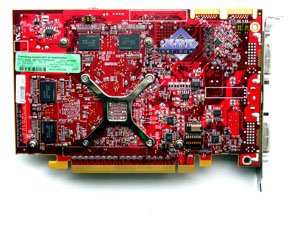Graphics card
| ATI RADEON HD 4670 512MB |
- GPU: RADEON HD 4670 (RV730)
- Interface: PCI-Express x16
- GPU frequencies (ROPs/Shaders): 750/750 MHz (nominal -- 750/750 MHz)
- Memory frequencies (physical (effective)): 1000 (2000) MHz (nominal -- 900-1000 (1800-2000) MHz)
- Memory bus width: 128bit
- Vertex processors: -
- Pixel processors: -
- Unified processors: 320
- Texture processors: 32 (BLF/TLF)
- ROPs: 8
- Dimensions: 190x100x15 mm (the last figure is maximum thickness of the graphics card).
- PCB color: red
- RAMDACs/TDMS: integrated into GPU.
- Output connectors: 2xDVI (Dual-Link/HDMI), TV-out.
- VIVO: not available
- TV-out: integrated into GPU.
- Multi-GPU operation: CrossFire (Hardware).
|
 |
| ATI RADEON HD 4670 512MB |
The graphics card has 512 MB of GDDR3 SDRAM allocated in eight chips (4 on each side of the PCB). Hynix memory chips (GDDR3). These memory chips are designed for the maximum frequency of 1000 (2000) MHz. |
 |
| Comparison with the reference design, front view |
| ATI RADEON HD 4670 512MB |
Reference ATI RADEON HD 3650 |
 |
 |
 |
| Comparison with the reference design, back view |
| ATI RADEON HD 4670 512MB |
Reference ATI RADEON HD 3650 |
 |
 |
As we can see, 3650 and 4670 have similar PCBs. That's easy to explain: same bus, same memory type, why re-invent the wheel. Besides, the new card consumes very little power, so there is no need to change power circuits significantly. Thus, both cards are very much alike.
The core has a small die installed at 45° to the substrate.
Graphics cards of this series feature built-in audio codecs, audio stream from which are transmitted to HDMI (via a DVI-to-HDMI adapter). So if this feature is important to you, make sure the bundle includes such an adapter.
Also note that the reviewed graphics card is powered only by the bus, requiring no additional power sources.
All cards have original TV-Out interfaces that require a special adapter to output video to a TV set via S-Video or RCA.
An analog monitor with a D-Sub (VGA) interface can be connected by means of a special DVI-to-D-Sub adapter. Also bundled are DVI-to-HDMI adapters (these graphics cards support video/audio output to HDMI receivers), so there should be no problems with such monitors.
Maximum resolutions and frequencies:
- 240 Hz maximum refresh rate
- 2048 x 1536 x 32bit @ 85Hz Max - analog interface
- 2560 x 1600 @ 60Hz Max - digital interface (all Dual-Link DVIs)
As for MPEG2 playback (DVD-Video), we analyzed this issue in 2002. Little has changed since that time. CPU load during video playback on modern graphics cards does not exceed 25%.
As for HDTV, a review is available here.
All cards require additional power source, so each is bundled with a molex to 6-pin adapter, even though all modern PSUs have such cables.
Cooling
Now let's take a look at the cooling system. It's very simple, we've seen it many times already -- a small closed heatsink made of copper alloy (so it's quite heavy).
The maximum turbine speed is 2500 rpm, so it's barely audible.
I just don't understand why cool memory on the front side with the same heatsink, leaving memory chips on the back side unattended. Wouldn't it be easier to re-make this cooler so its heatsink is wider and more efficient, but touches only the core?
We used RivaTuner (written by A.Nikolaychuk AKA Unwinder) to monitor operating temperatures.
As we can see, the card gets very hot for such a cheap device. Apparently, the reference cooling system is low-efficient. Let's hope AMD partners will offer better custom solutions for their cards.
Write a comment below. No registration needed!

